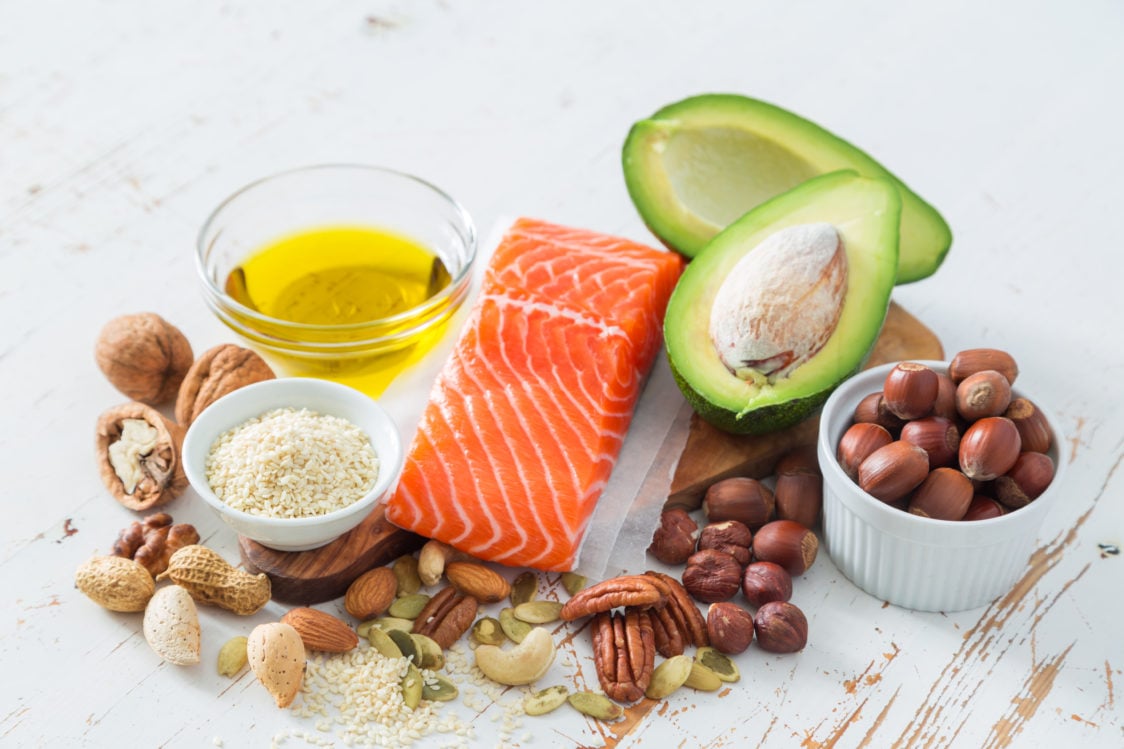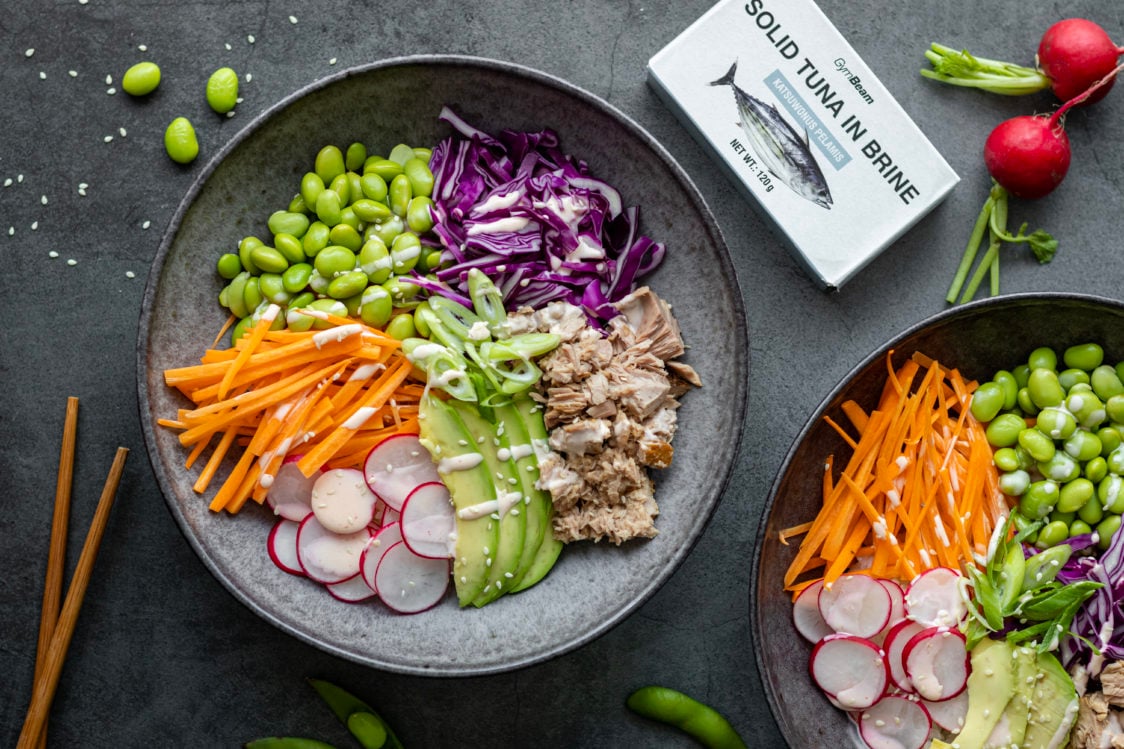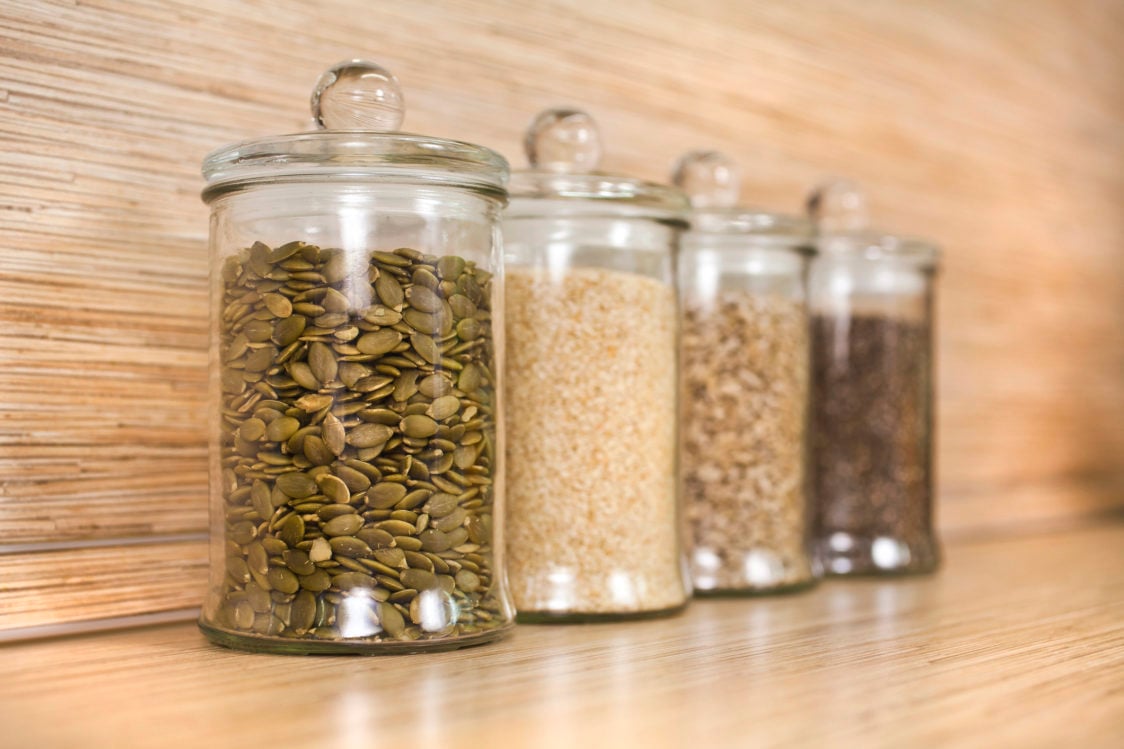Table of Contents
There is an ongoing debate about fats and their effects. It is one of those hot topics in nutrition that many people are confused about. Are vegetable or animal fats preferable? Is fat actually healthy, or will its intake give you a heart attack? In this article, we answer these and many other questions and help you to make your mind clear when it comes to fats.
How do you imagine fats in food?
Dietary fat is one of the three basic macronutrients (the other two are carbohydrates and protein) Fats are composed of glycerol and fatty acids (FA). The chemical bonds between the carbons in a fatty acid chain determine whether it is a saturated or unsaturated fatty acid.
- Saturated fatty acids have no double bond.
- Monounsaturated fatty acids have one double bond.
- Polyunsaturated fatty acids have two or more double bonds between the carbons.
The number of carbons, as well as the number of double bonds, determines the effect of fatty acids on health. There is always a combination of different fatty acids in fats and fatty foods. It is their content and ratio that determines the effect of a given food on your health. [3]
What is the function of fat in your diet?
Fats are a very important component of your diet without which many processes in the body would not be possible. They should therefore make up on average 20-35% of the total daily energy intake in your diet. [4,17]
- This nutrient is an important source of energy. 1g of fat is equivalent to 9 kcal (39 kJ), double the amount of protein and carbohydrates.
- Fat adds flavour and a pleasant texture to food.
- It also helps maintain a longer-lasting feeling of satiety because it is digested more slowly than other nutrients.
- Fats also help with the absorption of fat-soluble vitamins (vitamins A, D, E, K).
- Without fats, the production of certain hormones such as oestrogen or testosterone would not occur.
- Fatty acids also play a role in immune reactions or in the blood clotting process. [3,11,16]

What is body fat?
Body fat is stored as triacylglycerols (glycerol with three fatty acids attached) in fat cells (adipocytes).
- The accumulated adipocytes under the skin are part of the subcutaneous adipose tissue. You can see the subcutaneous fat, and it’s what you usually try to get rid of when you can’t fit into your favourite pants.
- In contrast, visceral fat encases internal organs and is only visible if a person has too much of it. Excess visceral fat will manifest itself in excessive waist circumference and carries an increased risk of type 2 diabetes, high blood pressure or heart disease. [9]
The amount of adipose tissue increases when your energy intake is higher than your energy expenditure. It increases not only after excessive intake of dietary fat, but also after excessive consumption of carbohydrates and protein. All nutrients are eventually converted into energy, which when in excess leads to fat storage in adipose tissue.
Conversely, when needed, fat can be released from these stores and used as a source of energy. Whether fat is stored, broken down or remains unchanged depends on the balance between energy intake and expenditure. You can calculate your optimal energy intake for weight loss, maintenance or weight gain using our online calculator.
What is the purpose of body fat?
- Adipose tissue serves as an energy reserve.
- Fat is an indispensable component of cell membranes. Every cell contains fats and they are virtually one of the building blocks of the body.
- Fat is an essential structural and functional component of the brain and nervous system. Not only is it part of the membranes of brain cells, but it also coats nerve fibres and plays a role in the transmission of nerve signals.
- Body fat helps regulate body temperature.
- It provides mechanical protection for internal organs.
- Adipose tissue also has the ability to produce hormones (called adipokines). These can, for example, affect immune function, insulin sensitivity or influence energy metabolism. For example, the hormone leptin impacts feelings of hunger and satiety. [3,11,16]

What fatty acids are there, and what are their health benefits?
It is not possible to say conclusively whether fats are healthy or unhealthy. It depends on the amount of fat in the diet and the proportion of specific fatty acids. Furthermore, it is their content in food that matters most. Which ones should predominate and which ones should you limit?
1. Saturated fatty acids
Saturated fatty acid fats (SAFA) can be easily identified by the fact that they are mostly solid at room temperature. These include all fats of animal origin, such as butter or lard. However, there are exceptions in the plant-based fat group, namely tropical palm fats such as coconut, palm and palm kernel fat. Plant sources of saturated fat also include cocoa butter.
Saturated fatty acids are also prevalent in all animal based foods – meat, meat products (ham, salami, sausages, etc.), eggs or dairy products.
Are saturated fatty acids harmful?
Excessive intake of saturated fatty acids has long been considered a major risk to heart and blood vessel health, particularly because of the potential negative effect on blood cholesterol levels. But currently, science is looking at them a little differently. It seems that it’s not SAFA alone that are threatening cardiovascular health. Rather, it’s probably food, especially highly industrialised processed products that contain a mix of salt, trans fats, preservatives and other substances along with SAFA, that are the risk factors.
In contrast, in dairy products or good quality dark chocolate, for example, saturated fat is combined with minerals, vitamins, beneficial milk proteins and other biologically active substances. As a result, the health benefits of the food may prevail. In addition to the nutrient content of individual foods, saturated fat needs to be considered in the context of overall dietary and lifestyle habits.
Make sure your diet includes plenty of vegetables, fruit, whole grain products and other foods that provide you with fibre, vitamins and other bioactive substances. This way, saturated fat intake from dairy products, meat, butter, etc. may not be as much of a problem as previously thought.
However, a diet based on fast food, hard salami and meat products, or fried foods with high levels of saturated fat combined with excessive salt, trans-fatty acids, preservatives and other added substances will have a potentially negative impact. [1,2,6]

What about coconut and MCT fat?
MCT fats are typically medium-chain fatty acids. This means they are metabolised more quickly and are used by the body as an immediate source of energy. Coconut fat in particular is often presented as a great source of MCT fat due to its high proportion of lauric acid (a medium chain fatty acid). In reality, however, this fatty acid behaves like a long-chain saturated acid. The results of scientific research point to the effect of coconut fat on raising blood cholesterol levels. The best thing to do, then, is to use it on your skin or hair and leave its place in the kitchen to another fat. [19]
How many saturated fatty acids can you have?
Recommendations on saturated fatty acid intake state that they should not make up more than 10% of your total daily energy intake. Using the reference for daily energy intake for a healthy adult (2000 kcal), this is 200 kcal. Also, this amount of energy is equivalent to 22 g of saturated fatty acids. For example, it can be found in 43 g of butter, 15 eggs or 210 g of cheese with 30% fat. [4]
Which foods contain the most saturated fatty acids?
- fatty meat, smoked meats (salami, sausages, bacon, etc.)
- butter, ghee, lard
- fatty dairy products (cheese, cream, creamy yoghurt)
- tropical palm fats – coconut oil, palm oil
- light pastries (croissants, etc.), sweets, cakes, creamy ice cream, chocolates, etc.
You might be interested in these products:
2. Monounsaturated fatty acids
Monounsaturated fatty acids (MUFA), known as omega-7 and omega-9, are found mainly in fats of plant origin. They can be found in vegetable oils, nuts, seeds or avocados. As with saturated fatty acids, monounsaturated FA are found in different combinations and proportions in food sources. [3]
What are benefis of MUFA?
Monounsaturated fatty acids are likely to help achieve an optimal ratio of total cholesterol to HDL (“good”) cholesterol in the blood. By keeping cholesterol in a healthy range, one can reduce the risk of developing atherosclerosis (a disease of the blood vessel wall in which fats and other substances build up, and the blood vessel gradually narrows) and the associated risk of heart attack or stroke.
The literature also talks about their positive effect on insulin sensitivity and blood pressure. Thus, a diet rich in MUFA may be a suitable part of prevention against, for example, the so-called metabolic syndrome, in which problems with blood pressure and high cholesterol occur together with obesity and type 2 diabetes mellitus. Including more MUFA in the diet will also be appreciated by those who already have these problems, as it can help improve overall health. [3,13]
What amount of MUFA should be in your diet?
MUFA should make up the majority of your total fat intake. The World Health Organisation recommends a daily intake of approximately 10-15% of your total daily energy intake in the form of monounsaturated fatty acids. With a reference intake of 2000 kcal, this range represents approximately 22-33g of MUFA. This is the amount found in about 35 ml of olive oil or about 100g of cashew nuts. [3, 4]
Which foods contain the most monounsaturated fatty acids?
- vegetable oils – sunflower, canola, olive, sesame
- nuts – almonds, pecan nuts, pistachios, macadamia nuts, hazelnuts
- peanuts
- seeds – pumpkin, sunflower
- avocado, avocado oil

3. Polyunsaturated fatty acids
Unlike saturated and monounsaturated FA, polyunsaturated fatty acids (PUFA) include those that your bodies cannot make themselves and must take in through food (called essential). PUFA are divided into omega-3 and omega-6 fatty acids, each of which have different effects.
Both plant foods (oils, nuts, etc.) and animal foods (especially fish) are good sources of polyunsaturated fatty acids (PUFA).
The recommended intake of polyunsaturated FA is 6-11% of total energy intake. At an intake of 2000 kcal, this is 13-24g of PUFA. [18]
3.1 Omega-3 fatty acids – what are their benefits and sources?
This group is touted for its numerous health benefits, and many of the omega-3 fatty acids are essential for the proper functioning of the body. An omega-3 fatty acid that is essential for you, and can only get it from your diet, is alpha-linolenic acid (ALA). It is found in flax seeds, flaxseed oil, canola oil, walnuts and their oil, chia seeds, wheat germ or soybean oil, etc. It is beneficial, for example, because of its positive effect on blood cholesterol levels. [11]
However, its conversion to the fatty acids EPA and DHA is also an important role. These long-chain acids are known for their positive effect on heart and brain function. They are involved in lowering blood pressure, blood triacylglycerol levels, have anti-inflammatory effects and also play a role, for example, in the treatment of cancer patients. However, the conversion of ALA to EPA and DHA is not sufficient. When you consider how often sources of alpha-linoleic acid appear in your diet, most of you will find that you have large reserves. Moreover, of the small amount you take in, only a fraction is converted to EPA and DHA (about 5% is converted to EPA and less than 0.5% to DHA). [4,11]
Therefore, if you want to achieve the recommended intake of eicosapentaenoic and docosahexaenoic acids, it is not a good idea to rely on their conversion from alpha-linolenic acid. EPA and DHA should therefore be taken from sources that are rich in them. Alpha-linolenic acid should account for 0.5-2% of your total energy intake. [18]

Which foods are the best sources of both EPA and DHA?
The main sources of eicosapentaenoic acid and docosahaexanoic acid are oily ocean fish and fish oil. How often do you have salmon, mackerel or herring? According to the recommendations, ocean fish should appear in your diet twice a week. Seaweed is also a good plant source of EPA and DHA. [7,15]
What is the average omega-3 content of different fish?
| Fish | Omega-3 content/100 g |
|---|---|
| salmon | 1.8 g |
| canned sardines | 1.7 g |
| herring | 1.2 g |
| mackerel | 1 g |
| trout | 1 g |
| canned tuna | 0.7g |
[15]
How much EPA and DHA do you need?
According to the European Food Safety Authority (EFSA) recommendations, a healthy adult should be consuming 250 mg of EPA and DHA per day. For example, in 100 g of salmon you take in up to seven times this amount. The 250 mg should serve as one component of protection against high cholesterol, blood pressure and other cardiovascular problems. Pregnant women should increase this dose by an additional 100 to 20 0mg in the form of DHA. [4]
The FAO (Food and Agriculture Organisation of the United Nations) recommends a range of 0.25-2 g of EPA and DHA per day. The upper limit can be reached, for example, with 117 g of canned sardines. [18]
However, achieving a diet with a sufficient intake of omega-3 fatty acids is challenging for most of us. If someone cuts out fish for various reasons, this task is virtually impossible. Therefore, there is no harm in considering supplementing with omega-3 FA in the form of dietary supplements that contain concentrated amounts of omega-3 FA from fish or fish oil. Vegans will appreciate supplements made from seaweed.
To learn more about polyunsaturated FA, read our article Omega-3 Fatty Acids: Do you Consume Enough and in the Right Ratio to Omega-6?
3.2 Omega-6 fatty acids – are they also good for you?
You often read that omega-6 fatty acids need to be reduced because of their possible harmful effects. The omega-6 essential acid, linoleic acid, is converted in the body into arachidonic acid, which is involved in the production of pro-inflammatory substances. But in fact, arachidonic acid also produces products that protect against inflammation and are also needed for proper blood clotting and, like omega-3 FA, help improve the condition of the heart and blood vessels. Ultimately, these are fatty acids with many benefits. [16]
Getting sufficient omega-6 in the diet is not as much of a problem as with omega-3 FA. Linoleic acid is abundantly present, for example, in sunflower oil, which many people commonly use in the kitchen. Other good sources include corn oil, soybean oil, but also sesame seeds, sesame oil, peanuts, pumpkin seeds, etc. On a daily basis, omega-6 should make up 2.5-9% of your total energy intake. [18]

Is the ratio of omega-6 to omega-3 important?
According to some recommendations, it is important to take omega-3 and omega-6 in the optimal ratio to balance their positive and possible negative effects. For example, the Czech Society for Nutrition recommends a 5:1 ratio in favour of omega-6 FA. However, nowadays, this ratio is commonly around 20:1. The intake of omega-6 is thus many times higher. This may entail, for example, a higher risk of excessive blood clotting, inflammatory processes in the body or atherosclerosis. [8,10]
The average person who just wants to eat healthy doesn’t have to try to achieve the exact recommended ratio of FA. All you need to do is carefully select your fat sources. Aim to increase your intake of omega-3 FA and, conversely, slightly reduce your intake of foods rich in omega-6 FA.
How do you do that?
- Aim for a higher intake of omega-3 fatty acids found in oily fish and eat them at least twice a week. Rotate the types of fish and the dishes you eat them in. For example, you can make different fish spreads, mix them into a salad or simply prepare fish with a side dish.
- Add flax seeds or flaxseed oil, walnuts or canola oil to your diet as they are excellent sources of alpha-linolenic acid.
- Consider supplementing Omega-3 FA in the form of dietary supplements.
- Limit the sources with the highest omega-6 FA content, such as sunflower, soybean or corn oil.
How can you determine what ratio of omega-3 and omega-6 you have in your body?
If you are wondering how much omega-3 and omega-6 FA are circulating in your body and whether you need to work on your dietary fat choices, a home diagnostic test can provide interesting information.
What is the ratio of fatty acids in different fats?

The quantities given are only average values, as the fats used in the analyses may differ in variety or, for example, in the degree of selection. In the USA, for example, sunflower oil with a higher proportion of oleic acid (MUFA) and a lower proportion of omega-6 is often used. At the same time, laboratory methods do not always capture all the fatty substances in the fat and therefore the final result may not be 100.
4. Trans fatty acids
Trans fatty acids (TFA) are considered the most risky fatty acids. Their intake increases the risk of cardiovascular disease. They are either produced naturally in the digestive tract of ruminants or as a result of industrial fat processing. It is those that are produced by improper technological treatment, namely partial solidification of fats, that are considered problematic. The World Health Organisation states that excessive intake of these fats increases the risk of coronary heart disease by 21% and the risk of death from heart disease by up to 28%. You should therefore pay attention to the content of partially solidified fats, which contain TFA, in the composition of food. [5,14]
Which foods contain partially solidified fat?
- cheap chocolate substitutes, confectionery with chocolate coating
- crackers, biscuits
- light and non-perishable pastries with fillings or toppings (croissants, etc.)
- dried soya beverages
- puff pastry and products made of it
- ready-made products, such as frozen pizza
Summary of recommended fatty acid intake
| Total amount of fat | SAFA | MUFA | Total amount of PUFA | Omega-3 fatty acids with PUFA | Omega-6 fatty acids with PUFA | Trans FA | |
|---|---|---|---|---|---|---|---|
| Daily recommended intake (% of total energy intake) | 20 – 35% | max. 10% | 10 – 15% | 6 – 11% | 0.5 – 2% | 2.5 – 9% | |
| Recommended intake with an energy intake of 2000 kcal | 44 – 78 g | 22 g | 22 – 33 g | 13 – 24 g | 1 – 4 g | 6 – 20 g |
Tips on how to supplement healthy fats and achieve an optimal amount in your diet

- Eat healthier and more diversified: The Healthy Plate Rule, for example, can help you achieve the optimal nutrient balance. ½ of your plate should be vegetables or fruit, ¼ complex carbohydrates and ¼ protein. Fat is always contained in foods of animal origin.
- Reduce your intake of the following foods: Highly processed foods such as various salty snacks (chips, etc.), any fast food, sweets, cakes, light pastries (croissants, doughnuts, etc.), biscuits, chocolates, fatty smoked meats, etc.
- Also limit: Various processed foods, pre-prepared frozen products, etc. This will not only reduce the amount of harmful trans-fatty acids, but also avoid excessive intake of so-called hidden fat. This lurks in places where you often don’t expect it.
- Increase your intake of monounsaturated and polyunsaturated fatty acids:
- When cooking and baking, use vegetable oils (those that are designed for this purpose). You can also use oil to jazz up your salad or add a drop for example, to pasta with sauce or creamy soups.
- Use various seeds as a garnish for salads and soups – sesame seeds, pumpkin seeds, etc.
- Seeds, nuts and nut butters rich in PUFA and MUFA can make any breakfast porridge, pancakes or yoghurt with fruit and granola more interesting.
- For sufficient EPA and DHA intake, include fatty ocean fish twice a week. You can classically prepare fresh fish with a side dish, but fish in pasta sauce or as part of a spread also counts. [12]
Control your portion sizes: To avoid excessive fat intake, use your hand as a reference when adding fat to food, e.g. in the form of oil, butter or nut butters. The serving size of the added fat should be the size of your thumb. [12]
Which sources of fat are best, and which ones to limit?
- These fats should make up the majority: olive oil, canola oil, flaxseed oil, walnut oil, walnuts, almonds, hazelnuts and other types of nuts, flax seeds, fatty ocean fish
- Eat less often: high-fat dairy products, meat, butter, sunflower oil, sunflower seeds, dark chocolate, soybean oil, peanuts, peanut oil, corn oil
- Keep these foods to a minimum: salami, sausages, bacon, fatty meats, foods containing partially solidified fat, fried foods, confectionery, light puff pastry, processed foods, fast food
What should you remember?
Fat is an indispensable part of your diet that you need for the proper functioning of your body. However, to avoid health problems, it is important to follow the recommended amount of fat intake per day and choose fats based on their fatty acid content.
Trans fatty acids should be reduced as much as possible, while saturated fatty acids should be reduced primarily by limiting highly processed products. You can boost your health by adding monounsaturated fatty acids in the form of various oils, nuts and seeds. You can also supplement healthy polyunsaturated fatty acids (especially omega-3 FA), which are often missing from our diets, with vegetable oils or ideally with oily fish.
Don’t forget to eat a varied and balanced diet. When you follow the principles of healthy eating and follow the healthy plate rule, for example, the amount and composition of fat in your diet will often change for the better, even without you having to make a concerted effort.
Did our article provide you with any new information? Share this interesting article with your friends.
[1] ASTRUP, A. et al. Dietary Saturated Fats and Health: Are the U.S. Guidelines Evidence-Based? – https://www.ncbi.nlm.nih.gov/pmc/articles/PMC8541481/
[2] ASTRUP, A. et al. Saturated Fats and Health: A Reassessment and Proposal for Food-Based Recommendations: JACC State-of-the-Art Review. – https://www.sciencedirect.com/science/article/pii/S0735109720356874
[3] DUYFF, R.L. Complete Food & Nutrition Guide. New York: Academy of Nutrition and Dietetics, 2017. ISBN 978-0-544-52058-5.
[4] EFSA PANEL ON DIETETIC PRODUCTS, NUTRITION, AND ALLERGIES (NDA) Scientific Opinion on Dietary Reference Values for fats, including saturated fatty acids, polyunsaturated fatty acids, monounsaturated fatty acids, trans fatty acids, and cholesterol. – https://onlinelibrary.wiley.com/doi/abs/10.2903/j.efsa.2010.1461
[5] ISLAM, M.A. et al. Trans fatty acids and lipid profile: A serious risk factor to cardiovascular disease, cancer and diabetes. – https://www.sciencedirect.com/science/article/abs/pii/S1871402119301420?via%3Dihub
[6] KAUR, D. et al. The health effects of saturated fats – the role of whole foods and dietary patterns. – https://www.sciencedirect.com/science/article/pii/S1871402120300230
[7] LANE, K. et al. Bioavailability and potential uses of vegetarian sources of omega-3 fatty acids: a review of the literature. – https://pubmed.ncbi.nlm.nih.gov/24261532/
[8] MINISTERSTVO ZDRAVOTNICTVÍ ČESKÉ REPUBLIKY. – http://www.szu.cz/uploads/documents/czzp/edice/vyzivova_doporuceni_pro_ob.CR.pdf>
[9] POWELL-WILEY, T.M. et al. Obesity and Cardiovascular Disease: A Scientific Statement From the American Heart Association. – https://www.ahajournals.org/doi/full/10.1161/CIR.0000000000000973
[10] SIMOPOULOS, A.P. An Increase in the Omega-6/Omega-3 Fatty Acid Ratio Increases the Risk for Obesity. – https://www.ncbi.nlm.nih.gov/pmc/articles/PMC4808858/
[11] EU Register of nutrition and health claims made on foods (v.3.6). – https://ec.europa.eu/food/safety/labelling_nutrition/claims/register/public/?event=search
[12] Hand Portion FAQ: A Guide from Precision Nutrition. – https://www.precisionnutrition.com/hand-portion-faq
[13] Metabolic Effects of Monounsaturated Fatty Acid–Enriched Diets Compared With Carbohydrate or Polyunsaturated Fatty Acid–Enriched Diets in Patients With Type 2 Diabetes: A Systematic Review and Meta-analysis of Randomized Controlled Trials PMC.– https://www.ncbi.nlm.nih.gov/pmc/articles/PMC4955926/
[14] WHO Nutrition: Trans fat.– https://www.who.int/news-room/questions-and-answers/item/nutrition-trans-fat
[15] EUFIC Omega-3 fatty acids: where to find them? – https://www.eufic.org/en/whats-in-food/article/omega-3-fatty-acids-where-to-find-them
[16] EUFIC The Functions of Fats in the Body. – https://www.eufic.org/en/whats-in-food/article/facts-on-fats-dietary-fats-and-health
[17] WHO | Healthy diet. – http://www.who.int/nutrition/publicatioAns/nutrientrequirements/healthydiet_factsheet/en/
[18] FAO Fats and fatty acids in human nutrition. – https://www.fao.org/3/i1953e/i1953e00.pdf
[19] NEELAKANTAN, N et al. The Effect of Coconut Oil Consumption on Cardiovascular Risk Factors. – https://www.ahajournals.org/doi/10.1161/CIRCULATIONAHA.119.043052?url_ver=Z39.88-2003&rfr_id=ori:rid:crossref.org&rfr_dat=cr_pub%20%200pubmed


Add a comment